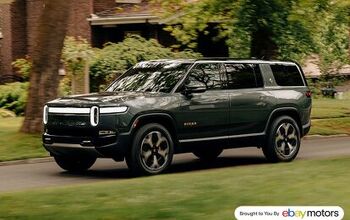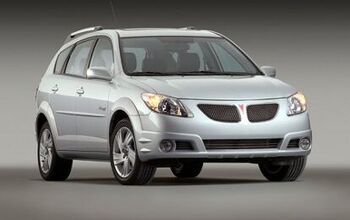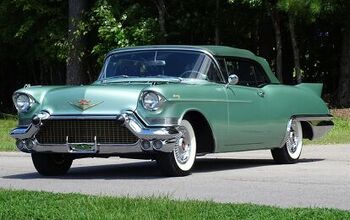General Motors Death Watch 48: The Price is Wrong
Regrets? GM's Vice President of North American Vehicle Sales has had a few. Then again, too few to mention. When quizzed about the wisdom of last summer's Fire Sale for Everyone, Monster Mark LaNeve said "Hindsight being 20/20, I probably wouldn't have done it." Probably? The campaign annihilated The General's fall and winter business and sealed GM's rep as America's largest discount car company. Which LaNeve now vows to fix by ignoring the connection between guilt and change and reanimating the company's short-lived "Total Value Promise" program.
Which is what, exactly? Although LaNeve's past rhetoric qualifies him for a job as the fifth Wiggle, and the specifics of the latest version of the Total Value Promise (TVP) await a Detroit unveiling, Monster Mark's been dropping hints. At the LA car confab, the slightly confessional marketing maven revealed the basics: lower sticker prices and a clear focus on comparative excellence. "We'll say, 'Best product, here's why," LaNeve said. "'Best price on an MSRP basis.'" What's more, "With every new product we bring to market, we'd like to price it very aggressively."
Not to coin a phrase, but the spin-out starts here. First of all, GM doesn't make the best products. While The General's camp followers will cry foul and cite various measurements placing GM vehicles head and fenders above the competition, the Chevrolet Corvette is the company's only undisputed class leader– and the $65k sports car division isn't exactly what you'd call crowded. Sure, GM's refreshed SUV's may turn out to be the business, but the majority of GM's products are also-rans. After all, if GM vehicles WERE the best of the best, the world's largest automaker wouldn't have to discount the damn things.
As for GM's plan to reduce advertised prices, well, we've been here before. In the brief period between Fire and Toe Tag sales, GM launched (pre-launched?) the TVP. Then as now, Monster Mark declared that GM's window stickers would be "closer" to the actual bottom line. The fact that this less-than-iron-clad "promise" was quickly and completely deep-sixed for yet another nationwide incentive campaign removed any chance consumers would believe GM's latest pledge. And why should they? You don't have to be a Keynesian economist to know that The General's inability to limit its supply guarantees a glut, which assures an eventual price cut. Lesson learned? Wait and prices will fall.
In fact, the whole concept of MSRP (Manufacturer's Suggested Retail Price) has been thoroughly discredited. Thanks to a seemingly endless succession of nationally-advertised discount campaigns, consumers now operate on the basis that a vehicle's MSRP is only an inflated starting point, or, if you prefer, meaningless. No one pays sticker. No one. How do consumers compare vehicle prices when they're subject to an ever-changing farrago of incentives and finance offers? The savvy ones go to independent websites like www.kbb.com, press a few buttons and sort it out. Given the confusion, volatility and newfound transparency of car prices, GM might as well lose the sticker and simply direct consumers to an appropriate website.
Obviously, legally, they can't do that. Equally obvious, strict TVP adherence is highly unlikely, veering towards impossible. Think of it this way: if one of GM's competitors reduces their prices with an incentive campaign, a TVP-faithful GM could only respond by lowering their advertised sticker price. That's not a strategy bound to please recent owners or dealers, whose livelihood depends on trying to maintain as much of the inflated MSRP as possible. It also flies in the face of common sense: what's built must be sold. If discounts are what American consumers need to get the iron off the lot, discounts is what they're gonna get.
The biggest problem with TVP is that GM is, as always, hedging its bets. Note LaNeve's use of MSRP as a measure of relative price; GM is not promising to have the best price relative to the competition in absolute terms. By the same token, LaNeve said he would "like" to price new vehicles aggressively, not that he 'will.' In truth, there's only one alternative to the current rebate-driven set-up: the no-dicker sticker. If GM really wants to eliminate incentives, they have to say 'this is the price for this vehicle.' Period.
You could certainly posit that much of the Fire Sale for Everyone's success was due to the [perceived] lack of price negotiation. You could also credibly maintain that non-negotiable prices assured the Saturn brand's initial survival. But you'd have a hard time arguing that GM's management has the stones to weather the inevitable fall-out from a no-haggle pricing policy, as dealers scream bloody murder and duff vehicles pile-up in their thousands. Bottom line: expect GM's TVP to fade into obscurity for the second time, replaced by yet another round of rebates. And once again, Monster Mark LaNeve will be left without regrets.
More by Robert Farago
Latest Car Reviews
Read moreLatest Product Reviews
Read moreRecent Comments
- V8fairy Not scared, but I would be reluctant to put my trust in it. The technology is just not quite there yet
- V8fairy Headlights that switch on/off with the ignition - similar to the requirement that Sweden has- lights must run any time the car is on.Definitely knobs and buttons, touchscreens should only be for navigation and phone mirroring and configuration of non essential items like stereo balance/ fade etc>Bagpipes for following too close.A following distance warning system - I'd be happy to see made mandatory. And bagpipes would be a good choice for this, so hard to put up with!ABS probably should be a mandatory requirementI personally would like to have blind spot monitoring, although should absolutely NOT be mandatory. Is there a blind spot monitoring kit that could be rerofitted to a 1980 Cadillac?
- IBx1 A manual transmission
- Bd2 All these inane posts (often referencing Hyundai, Kia) the past week are by "Anal" who has been using my handle, so just ignore them...
- 3-On-The-Tree I was disappointed that when I bought my 2002 Suzuki GSX1300R that the Europeans put a mandatory speed limiter on it from 197mph down to 186mph for the 2002 year U.S models.


































Comments
Join the conversation